Qatar's Sustainable Tourism Development: Planning, Impact, and Issues
VerifiedAdded on 2023/03/21
|14
|4265
|86
Report
AI Summary
This report provides a comprehensive analysis of sustainable tourism development in Qatar. It begins with an introduction to the tourism industry's impact on the economy and the goals of sustainable development, emphasizing economic opportunity, cultural preservation, and quality of life. The report then delves into the benefits of stakeholder engagement in Qatar's tourism sector, including developers, local residents, investors, and the government. It also examines the advantages and disadvantages of public/private tourism planning partnerships, highlighting employment opportunities, infrastructure development, and environmental protection. The report further explores the features of Qatar's tourism development plan at international, national, regional, and sub-regional levels, emphasizing the significance of an interactive planning system. Different methods for measuring tourism impact, such as the Cambridge economic impact model, environmental impact studies, and social impact studies, are discussed. Finally, the report introduces the concept of sustainability in tourism, explaining the Triple Bottom Line Model and identifying factors that prevent sustainable tourism development. The report covers various aspects of Qatar's tourism planning and development, providing a detailed overview of the country's strategies and challenges in achieving sustainable tourism goals.
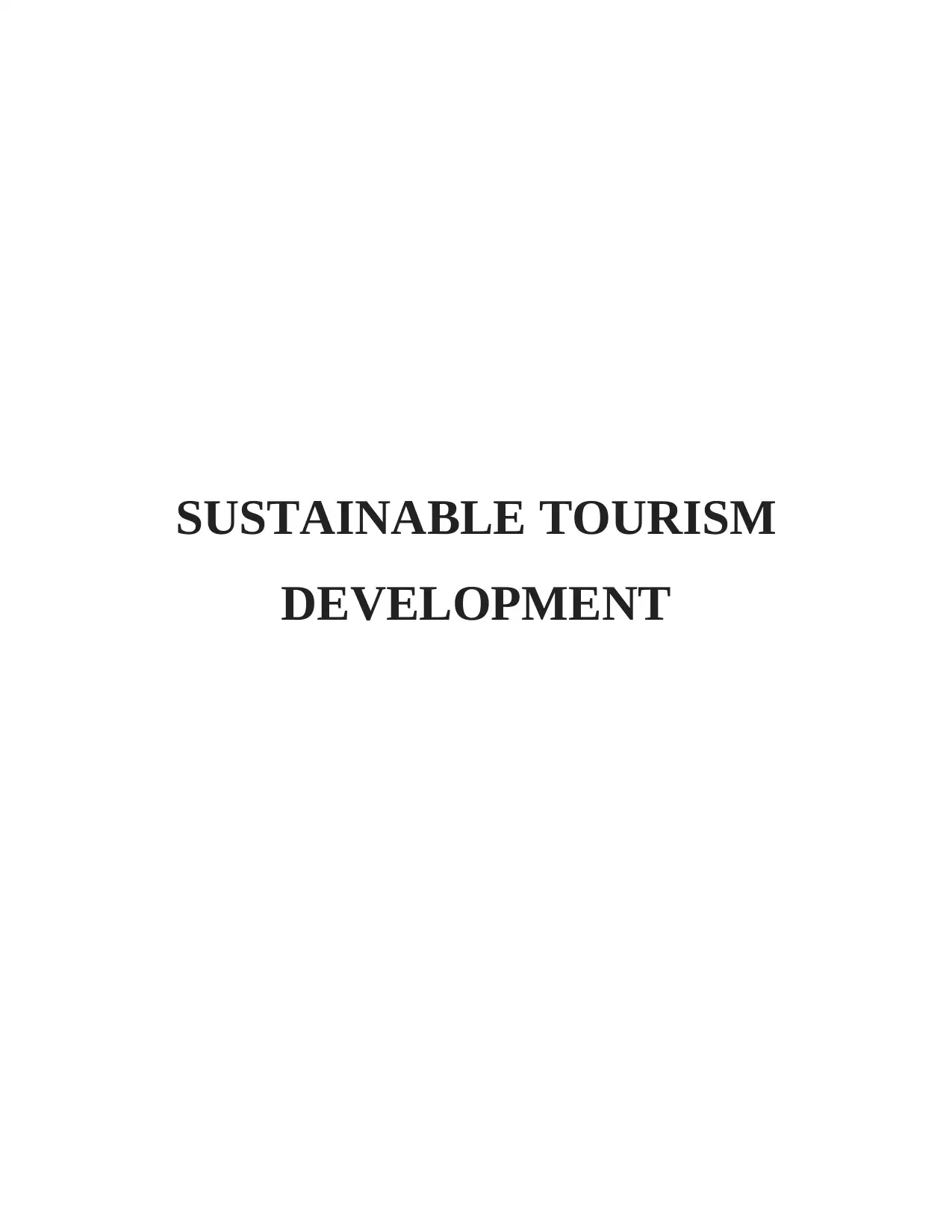
SUSTAINABLE TOURISM
DEVELOPMENT
DEVELOPMENT
Paraphrase This Document
Need a fresh take? Get an instant paraphrase of this document with our AI Paraphraser
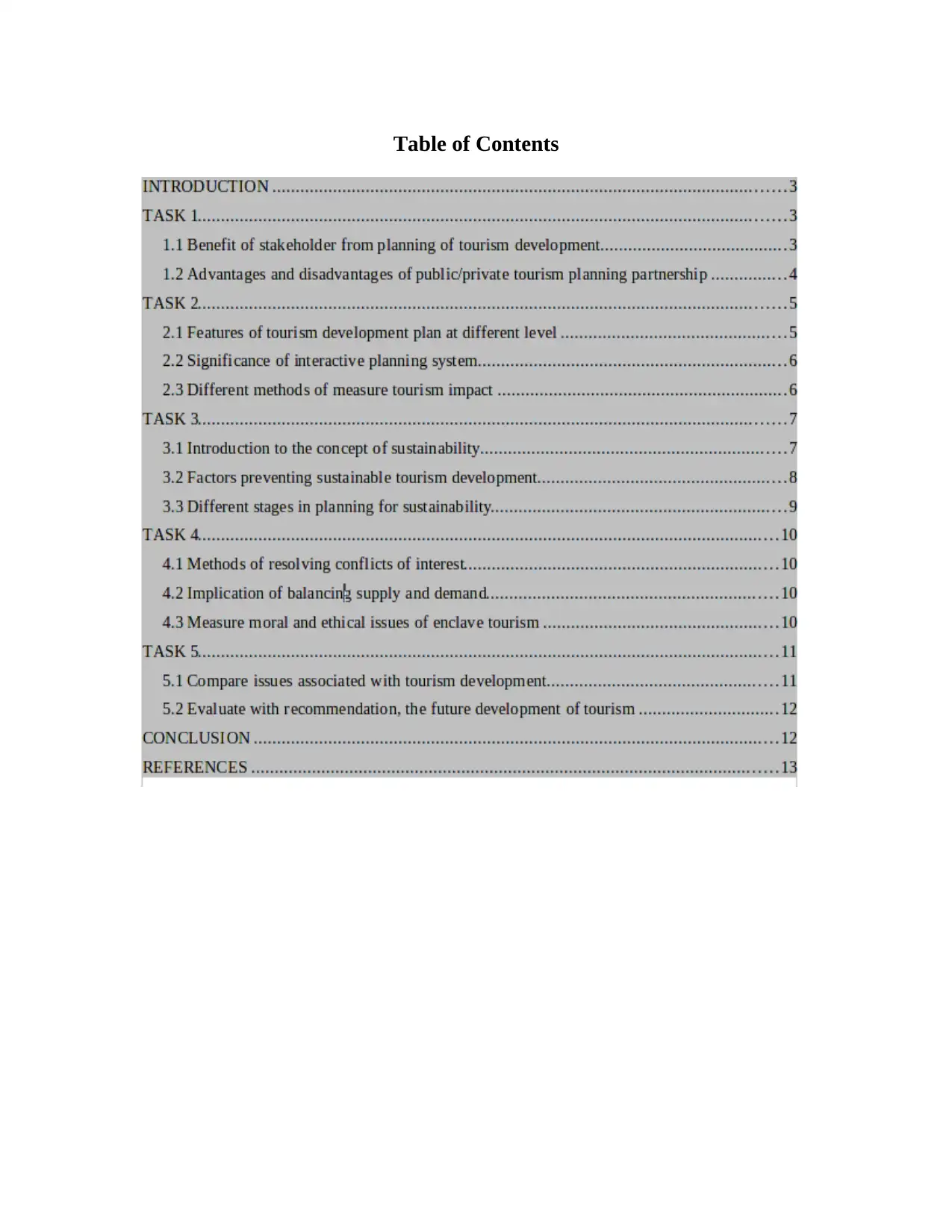
Table of Contents
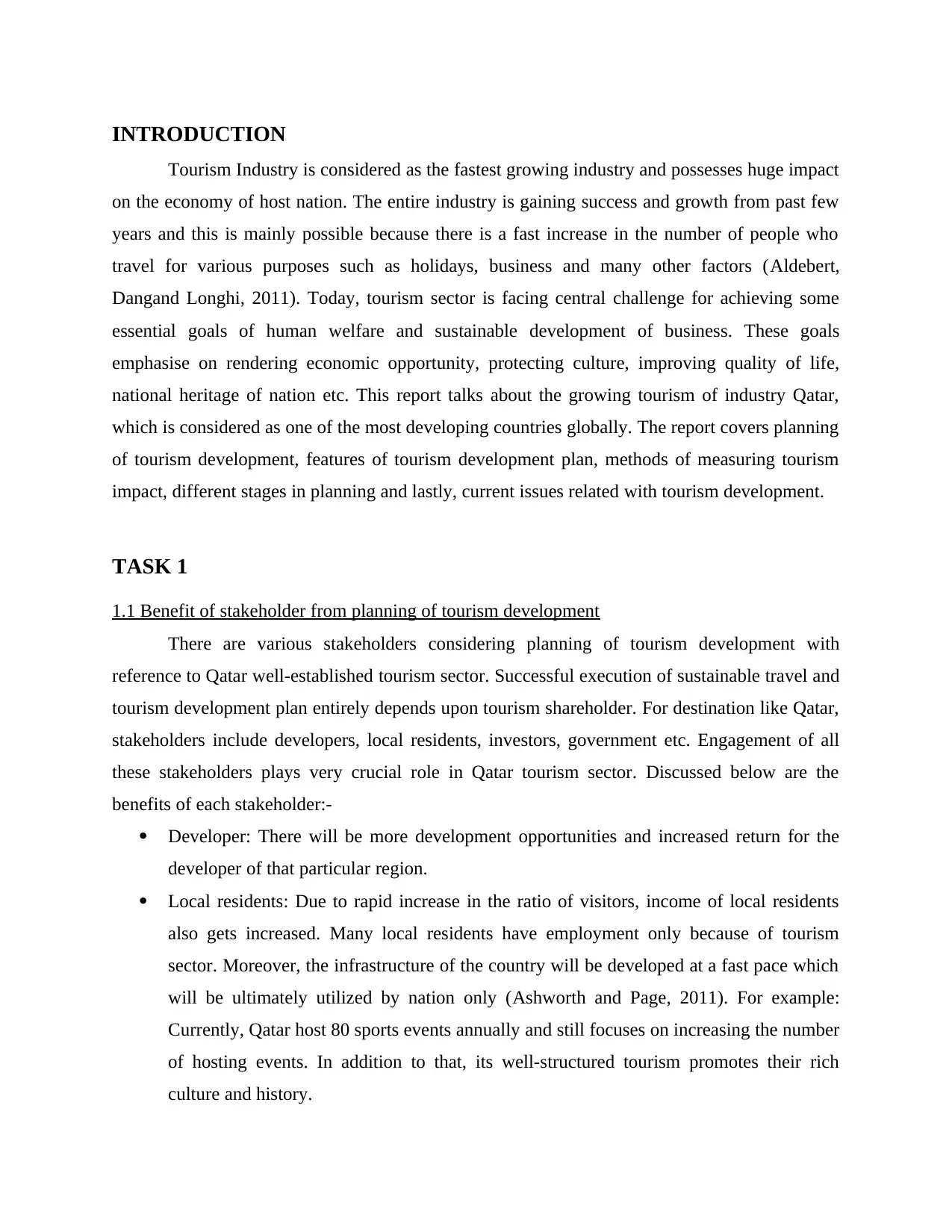
INTRODUCTION
Tourism Industry is considered as the fastest growing industry and possesses huge impact
on the economy of host nation. The entire industry is gaining success and growth from past few
years and this is mainly possible because there is a fast increase in the number of people who
travel for various purposes such as holidays, business and many other factors (Aldebert,
Dangand Longhi, 2011). Today, tourism sector is facing central challenge for achieving some
essential goals of human welfare and sustainable development of business. These goals
emphasise on rendering economic opportunity, protecting culture, improving quality of life,
national heritage of nation etc. This report talks about the growing tourism of industry Qatar,
which is considered as one of the most developing countries globally. The report covers planning
of tourism development, features of tourism development plan, methods of measuring tourism
impact, different stages in planning and lastly, current issues related with tourism development.
TASK 1
1.1 Benefit of stakeholder from planning of tourism development
There are various stakeholders considering planning of tourism development with
reference to Qatar well-established tourism sector. Successful execution of sustainable travel and
tourism development plan entirely depends upon tourism shareholder. For destination like Qatar,
stakeholders include developers, local residents, investors, government etc. Engagement of all
these stakeholders plays very crucial role in Qatar tourism sector. Discussed below are the
benefits of each stakeholder:-
Developer: There will be more development opportunities and increased return for the
developer of that particular region.
Local residents: Due to rapid increase in the ratio of visitors, income of local residents
also gets increased. Many local residents have employment only because of tourism
sector. Moreover, the infrastructure of the country will be developed at a fast pace which
will be ultimately utilized by nation only (Ashworth and Page, 2011). For example:
Currently, Qatar host 80 sports events annually and still focuses on increasing the number
of hosting events. In addition to that, its well-structured tourism promotes their rich
culture and history.
Tourism Industry is considered as the fastest growing industry and possesses huge impact
on the economy of host nation. The entire industry is gaining success and growth from past few
years and this is mainly possible because there is a fast increase in the number of people who
travel for various purposes such as holidays, business and many other factors (Aldebert,
Dangand Longhi, 2011). Today, tourism sector is facing central challenge for achieving some
essential goals of human welfare and sustainable development of business. These goals
emphasise on rendering economic opportunity, protecting culture, improving quality of life,
national heritage of nation etc. This report talks about the growing tourism of industry Qatar,
which is considered as one of the most developing countries globally. The report covers planning
of tourism development, features of tourism development plan, methods of measuring tourism
impact, different stages in planning and lastly, current issues related with tourism development.
TASK 1
1.1 Benefit of stakeholder from planning of tourism development
There are various stakeholders considering planning of tourism development with
reference to Qatar well-established tourism sector. Successful execution of sustainable travel and
tourism development plan entirely depends upon tourism shareholder. For destination like Qatar,
stakeholders include developers, local residents, investors, government etc. Engagement of all
these stakeholders plays very crucial role in Qatar tourism sector. Discussed below are the
benefits of each stakeholder:-
Developer: There will be more development opportunities and increased return for the
developer of that particular region.
Local residents: Due to rapid increase in the ratio of visitors, income of local residents
also gets increased. Many local residents have employment only because of tourism
sector. Moreover, the infrastructure of the country will be developed at a fast pace which
will be ultimately utilized by nation only (Ashworth and Page, 2011). For example:
Currently, Qatar host 80 sports events annually and still focuses on increasing the number
of hosting events. In addition to that, its well-structured tourism promotes their rich
culture and history.
⊘ This is a preview!⊘
Do you want full access?
Subscribe today to unlock all pages.

Trusted by 1+ million students worldwide
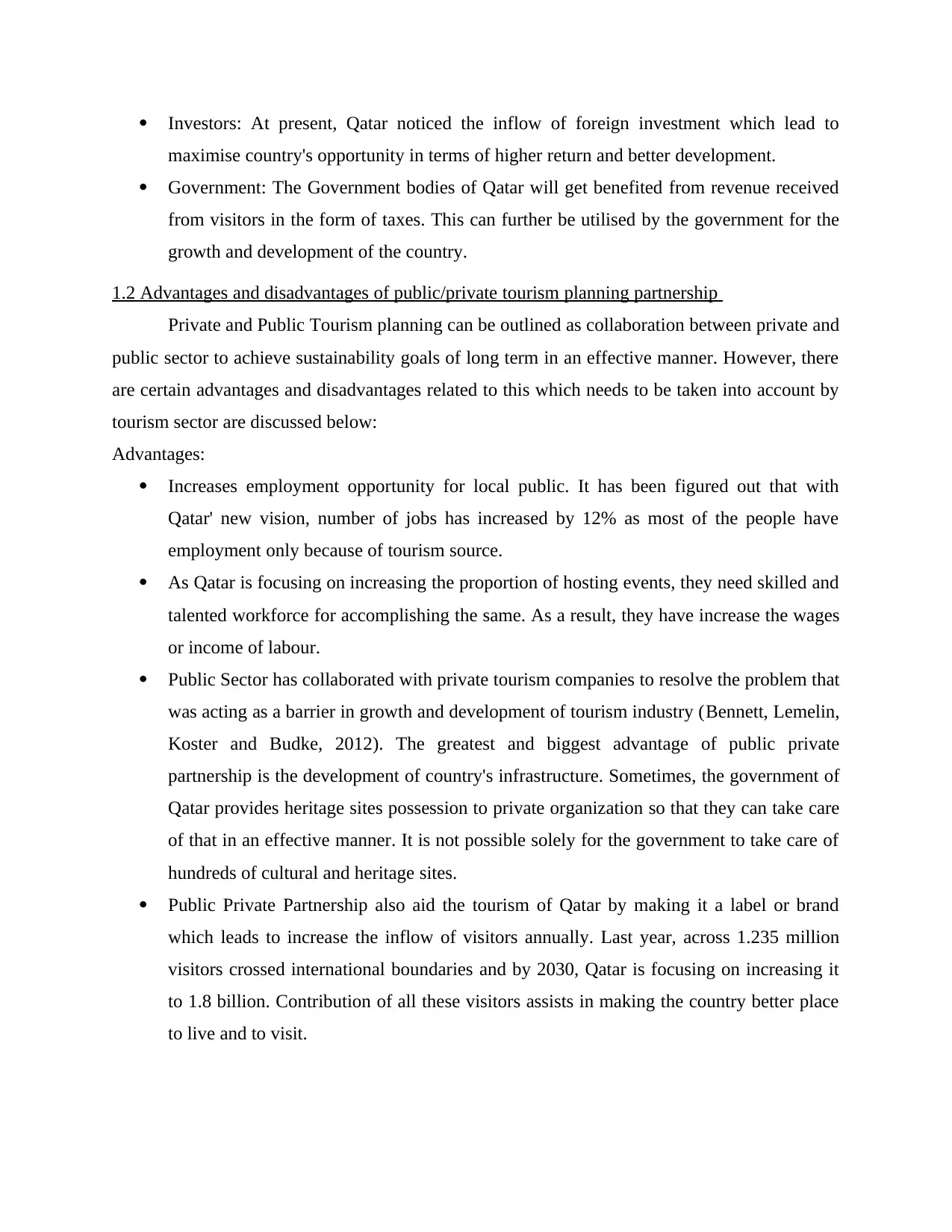
Investors: At present, Qatar noticed the inflow of foreign investment which lead to
maximise country's opportunity in terms of higher return and better development.
Government: The Government bodies of Qatar will get benefited from revenue received
from visitors in the form of taxes. This can further be utilised by the government for the
growth and development of the country.
1.2 Advantages and disadvantages of public/private tourism planning partnership
Private and Public Tourism planning can be outlined as collaboration between private and
public sector to achieve sustainability goals of long term in an effective manner. However, there
are certain advantages and disadvantages related to this which needs to be taken into account by
tourism sector are discussed below:
Advantages:
Increases employment opportunity for local public. It has been figured out that with
Qatar' new vision, number of jobs has increased by 12% as most of the people have
employment only because of tourism source.
As Qatar is focusing on increasing the proportion of hosting events, they need skilled and
talented workforce for accomplishing the same. As a result, they have increase the wages
or income of labour.
Public Sector has collaborated with private tourism companies to resolve the problem that
was acting as a barrier in growth and development of tourism industry (Bennett, Lemelin,
Koster and Budke, 2012). The greatest and biggest advantage of public private
partnership is the development of country's infrastructure. Sometimes, the government of
Qatar provides heritage sites possession to private organization so that they can take care
of that in an effective manner. It is not possible solely for the government to take care of
hundreds of cultural and heritage sites.
Public Private Partnership also aid the tourism of Qatar by making it a label or brand
which leads to increase the inflow of visitors annually. Last year, across 1.235 million
visitors crossed international boundaries and by 2030, Qatar is focusing on increasing it
to 1.8 billion. Contribution of all these visitors assists in making the country better place
to live and to visit.
maximise country's opportunity in terms of higher return and better development.
Government: The Government bodies of Qatar will get benefited from revenue received
from visitors in the form of taxes. This can further be utilised by the government for the
growth and development of the country.
1.2 Advantages and disadvantages of public/private tourism planning partnership
Private and Public Tourism planning can be outlined as collaboration between private and
public sector to achieve sustainability goals of long term in an effective manner. However, there
are certain advantages and disadvantages related to this which needs to be taken into account by
tourism sector are discussed below:
Advantages:
Increases employment opportunity for local public. It has been figured out that with
Qatar' new vision, number of jobs has increased by 12% as most of the people have
employment only because of tourism source.
As Qatar is focusing on increasing the proportion of hosting events, they need skilled and
talented workforce for accomplishing the same. As a result, they have increase the wages
or income of labour.
Public Sector has collaborated with private tourism companies to resolve the problem that
was acting as a barrier in growth and development of tourism industry (Bennett, Lemelin,
Koster and Budke, 2012). The greatest and biggest advantage of public private
partnership is the development of country's infrastructure. Sometimes, the government of
Qatar provides heritage sites possession to private organization so that they can take care
of that in an effective manner. It is not possible solely for the government to take care of
hundreds of cultural and heritage sites.
Public Private Partnership also aid the tourism of Qatar by making it a label or brand
which leads to increase the inflow of visitors annually. Last year, across 1.235 million
visitors crossed international boundaries and by 2030, Qatar is focusing on increasing it
to 1.8 billion. Contribution of all these visitors assists in making the country better place
to live and to visit.
Paraphrase This Document
Need a fresh take? Get an instant paraphrase of this document with our AI Paraphraser
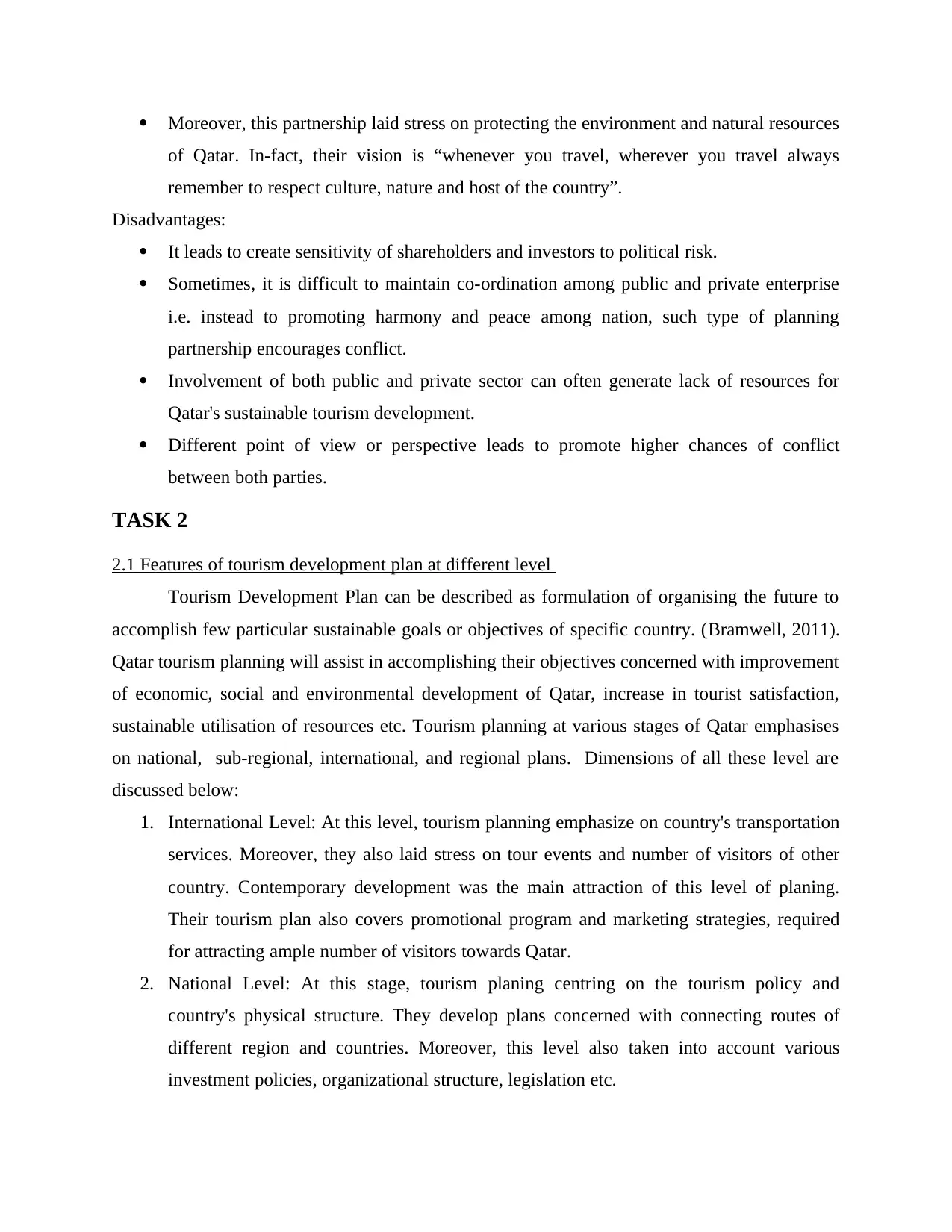
Moreover, this partnership laid stress on protecting the environment and natural resources
of Qatar. In-fact, their vision is “whenever you travel, wherever you travel always
remember to respect culture, nature and host of the country”.
Disadvantages:
It leads to create sensitivity of shareholders and investors to political risk.
Sometimes, it is difficult to maintain co-ordination among public and private enterprise
i.e. instead to promoting harmony and peace among nation, such type of planning
partnership encourages conflict.
Involvement of both public and private sector can often generate lack of resources for
Qatar's sustainable tourism development.
Different point of view or perspective leads to promote higher chances of conflict
between both parties.
TASK 2
2.1 Features of tourism development plan at different level
Tourism Development Plan can be described as formulation of organising the future to
accomplish few particular sustainable goals or objectives of specific country. (Bramwell, 2011).
Qatar tourism planning will assist in accomplishing their objectives concerned with improvement
of economic, social and environmental development of Qatar, increase in tourist satisfaction,
sustainable utilisation of resources etc. Tourism planning at various stages of Qatar emphasises
on national, sub-regional, international, and regional plans. Dimensions of all these level are
discussed below:
1. International Level: At this level, tourism planning emphasize on country's transportation
services. Moreover, they also laid stress on tour events and number of visitors of other
country. Contemporary development was the main attraction of this level of planing.
Their tourism plan also covers promotional program and marketing strategies, required
for attracting ample number of visitors towards Qatar.
2. National Level: At this stage, tourism planing centring on the tourism policy and
country's physical structure. They develop plans concerned with connecting routes of
different region and countries. Moreover, this level also taken into account various
investment policies, organizational structure, legislation etc.
of Qatar. In-fact, their vision is “whenever you travel, wherever you travel always
remember to respect culture, nature and host of the country”.
Disadvantages:
It leads to create sensitivity of shareholders and investors to political risk.
Sometimes, it is difficult to maintain co-ordination among public and private enterprise
i.e. instead to promoting harmony and peace among nation, such type of planning
partnership encourages conflict.
Involvement of both public and private sector can often generate lack of resources for
Qatar's sustainable tourism development.
Different point of view or perspective leads to promote higher chances of conflict
between both parties.
TASK 2
2.1 Features of tourism development plan at different level
Tourism Development Plan can be described as formulation of organising the future to
accomplish few particular sustainable goals or objectives of specific country. (Bramwell, 2011).
Qatar tourism planning will assist in accomplishing their objectives concerned with improvement
of economic, social and environmental development of Qatar, increase in tourist satisfaction,
sustainable utilisation of resources etc. Tourism planning at various stages of Qatar emphasises
on national, sub-regional, international, and regional plans. Dimensions of all these level are
discussed below:
1. International Level: At this level, tourism planning emphasize on country's transportation
services. Moreover, they also laid stress on tour events and number of visitors of other
country. Contemporary development was the main attraction of this level of planing.
Their tourism plan also covers promotional program and marketing strategies, required
for attracting ample number of visitors towards Qatar.
2. National Level: At this stage, tourism planing centring on the tourism policy and
country's physical structure. They develop plans concerned with connecting routes of
different region and countries. Moreover, this level also taken into account various
investment policies, organizational structure, legislation etc.
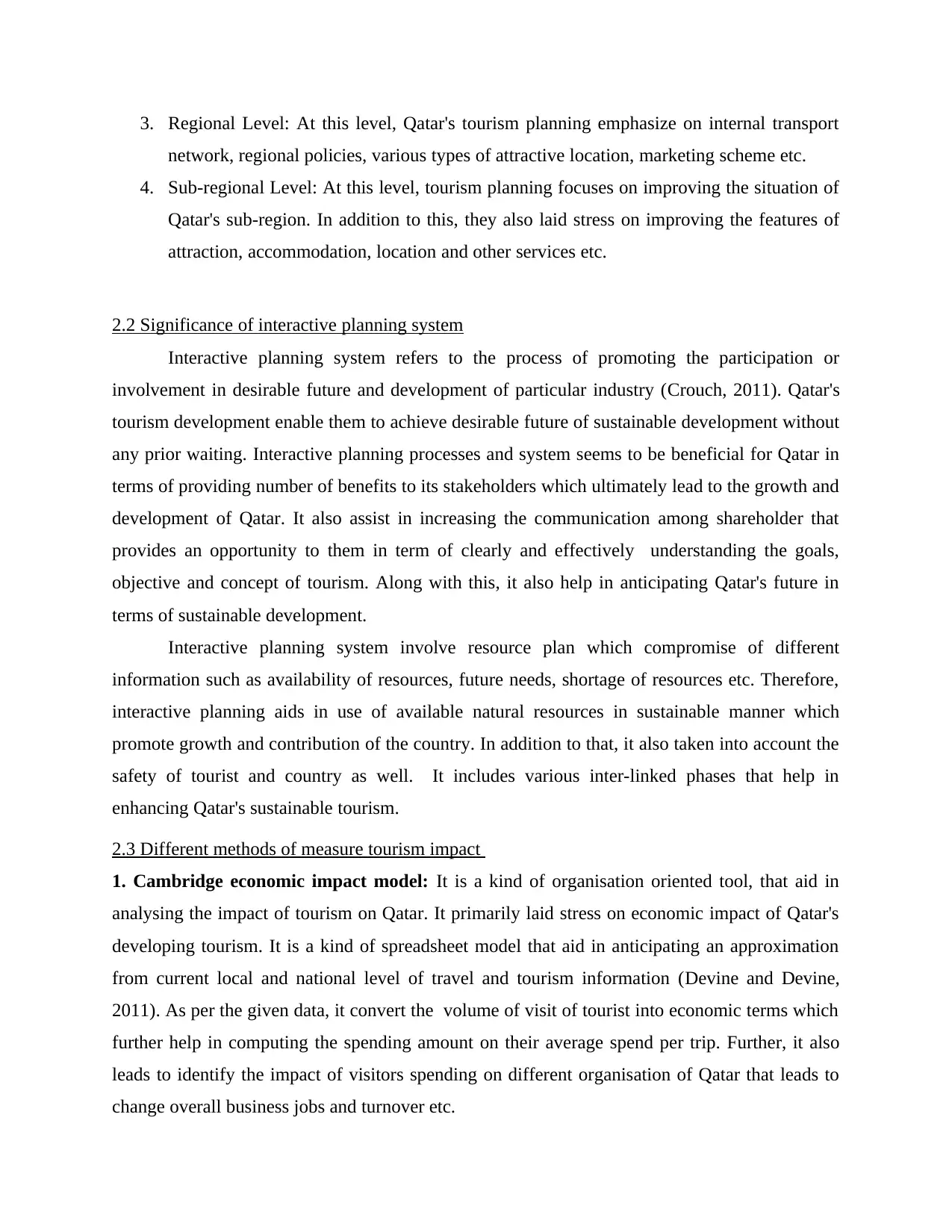
3. Regional Level: At this level, Qatar's tourism planning emphasize on internal transport
network, regional policies, various types of attractive location, marketing scheme etc.
4. Sub-regional Level: At this level, tourism planning focuses on improving the situation of
Qatar's sub-region. In addition to this, they also laid stress on improving the features of
attraction, accommodation, location and other services etc.
2.2 Significance of interactive planning system
Interactive planning system refers to the process of promoting the participation or
involvement in desirable future and development of particular industry (Crouch, 2011). Qatar's
tourism development enable them to achieve desirable future of sustainable development without
any prior waiting. Interactive planning processes and system seems to be beneficial for Qatar in
terms of providing number of benefits to its stakeholders which ultimately lead to the growth and
development of Qatar. It also assist in increasing the communication among shareholder that
provides an opportunity to them in term of clearly and effectively understanding the goals,
objective and concept of tourism. Along with this, it also help in anticipating Qatar's future in
terms of sustainable development.
Interactive planning system involve resource plan which compromise of different
information such as availability of resources, future needs, shortage of resources etc. Therefore,
interactive planning aids in use of available natural resources in sustainable manner which
promote growth and contribution of the country. In addition to that, it also taken into account the
safety of tourist and country as well. It includes various inter-linked phases that help in
enhancing Qatar's sustainable tourism.
2.3 Different methods of measure tourism impact
1. Cambridge economic impact model: It is a kind of organisation oriented tool, that aid in
analysing the impact of tourism on Qatar. It primarily laid stress on economic impact of Qatar's
developing tourism. It is a kind of spreadsheet model that aid in anticipating an approximation
from current local and national level of travel and tourism information (Devine and Devine,
2011). As per the given data, it convert the volume of visit of tourist into economic terms which
further help in computing the spending amount on their average spend per trip. Further, it also
leads to identify the impact of visitors spending on different organisation of Qatar that leads to
change overall business jobs and turnover etc.
network, regional policies, various types of attractive location, marketing scheme etc.
4. Sub-regional Level: At this level, tourism planning focuses on improving the situation of
Qatar's sub-region. In addition to this, they also laid stress on improving the features of
attraction, accommodation, location and other services etc.
2.2 Significance of interactive planning system
Interactive planning system refers to the process of promoting the participation or
involvement in desirable future and development of particular industry (Crouch, 2011). Qatar's
tourism development enable them to achieve desirable future of sustainable development without
any prior waiting. Interactive planning processes and system seems to be beneficial for Qatar in
terms of providing number of benefits to its stakeholders which ultimately lead to the growth and
development of Qatar. It also assist in increasing the communication among shareholder that
provides an opportunity to them in term of clearly and effectively understanding the goals,
objective and concept of tourism. Along with this, it also help in anticipating Qatar's future in
terms of sustainable development.
Interactive planning system involve resource plan which compromise of different
information such as availability of resources, future needs, shortage of resources etc. Therefore,
interactive planning aids in use of available natural resources in sustainable manner which
promote growth and contribution of the country. In addition to that, it also taken into account the
safety of tourist and country as well. It includes various inter-linked phases that help in
enhancing Qatar's sustainable tourism.
2.3 Different methods of measure tourism impact
1. Cambridge economic impact model: It is a kind of organisation oriented tool, that aid in
analysing the impact of tourism on Qatar. It primarily laid stress on economic impact of Qatar's
developing tourism. It is a kind of spreadsheet model that aid in anticipating an approximation
from current local and national level of travel and tourism information (Devine and Devine,
2011). As per the given data, it convert the volume of visit of tourist into economic terms which
further help in computing the spending amount on their average spend per trip. Further, it also
leads to identify the impact of visitors spending on different organisation of Qatar that leads to
change overall business jobs and turnover etc.
⊘ This is a preview!⊘
Do you want full access?
Subscribe today to unlock all pages.

Trusted by 1+ million students worldwide
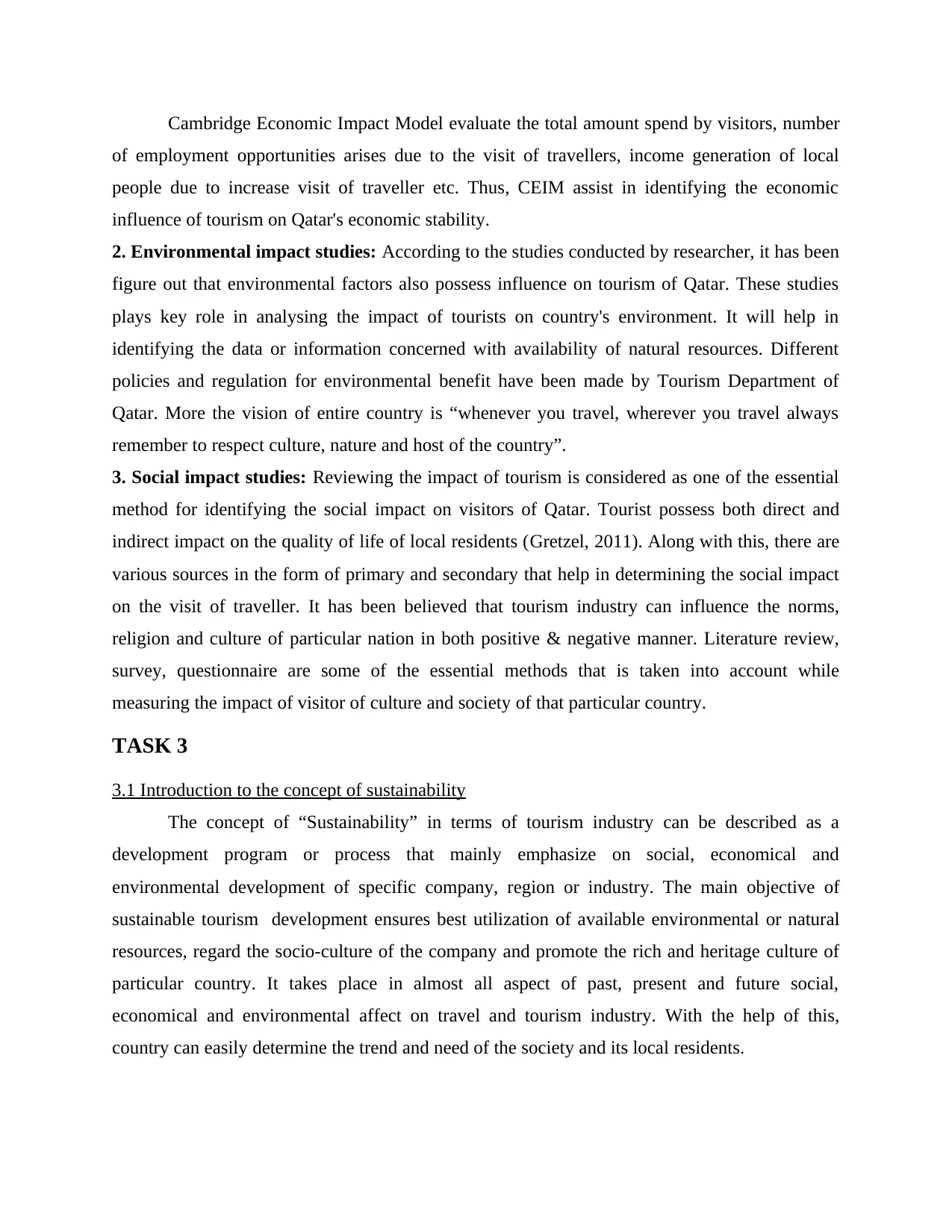
Cambridge Economic Impact Model evaluate the total amount spend by visitors, number
of employment opportunities arises due to the visit of travellers, income generation of local
people due to increase visit of traveller etc. Thus, CEIM assist in identifying the economic
influence of tourism on Qatar's economic stability.
2. Environmental impact studies: According to the studies conducted by researcher, it has been
figure out that environmental factors also possess influence on tourism of Qatar. These studies
plays key role in analysing the impact of tourists on country's environment. It will help in
identifying the data or information concerned with availability of natural resources. Different
policies and regulation for environmental benefit have been made by Tourism Department of
Qatar. More the vision of entire country is “whenever you travel, wherever you travel always
remember to respect culture, nature and host of the country”.
3. Social impact studies: Reviewing the impact of tourism is considered as one of the essential
method for identifying the social impact on visitors of Qatar. Tourist possess both direct and
indirect impact on the quality of life of local residents (Gretzel, 2011). Along with this, there are
various sources in the form of primary and secondary that help in determining the social impact
on the visit of traveller. It has been believed that tourism industry can influence the norms,
religion and culture of particular nation in both positive & negative manner. Literature review,
survey, questionnaire are some of the essential methods that is taken into account while
measuring the impact of visitor of culture and society of that particular country.
TASK 3
3.1 Introduction to the concept of sustainability
The concept of “Sustainability” in terms of tourism industry can be described as a
development program or process that mainly emphasize on social, economical and
environmental development of specific company, region or industry. The main objective of
sustainable tourism development ensures best utilization of available environmental or natural
resources, regard the socio-culture of the company and promote the rich and heritage culture of
particular country. It takes place in almost all aspect of past, present and future social,
economical and environmental affect on travel and tourism industry. With the help of this,
country can easily determine the trend and need of the society and its local residents.
of employment opportunities arises due to the visit of travellers, income generation of local
people due to increase visit of traveller etc. Thus, CEIM assist in identifying the economic
influence of tourism on Qatar's economic stability.
2. Environmental impact studies: According to the studies conducted by researcher, it has been
figure out that environmental factors also possess influence on tourism of Qatar. These studies
plays key role in analysing the impact of tourists on country's environment. It will help in
identifying the data or information concerned with availability of natural resources. Different
policies and regulation for environmental benefit have been made by Tourism Department of
Qatar. More the vision of entire country is “whenever you travel, wherever you travel always
remember to respect culture, nature and host of the country”.
3. Social impact studies: Reviewing the impact of tourism is considered as one of the essential
method for identifying the social impact on visitors of Qatar. Tourist possess both direct and
indirect impact on the quality of life of local residents (Gretzel, 2011). Along with this, there are
various sources in the form of primary and secondary that help in determining the social impact
on the visit of traveller. It has been believed that tourism industry can influence the norms,
religion and culture of particular nation in both positive & negative manner. Literature review,
survey, questionnaire are some of the essential methods that is taken into account while
measuring the impact of visitor of culture and society of that particular country.
TASK 3
3.1 Introduction to the concept of sustainability
The concept of “Sustainability” in terms of tourism industry can be described as a
development program or process that mainly emphasize on social, economical and
environmental development of specific company, region or industry. The main objective of
sustainable tourism development ensures best utilization of available environmental or natural
resources, regard the socio-culture of the company and promote the rich and heritage culture of
particular country. It takes place in almost all aspect of past, present and future social,
economical and environmental affect on travel and tourism industry. With the help of this,
country can easily determine the trend and need of the society and its local residents.
Paraphrase This Document
Need a fresh take? Get an instant paraphrase of this document with our AI Paraphraser
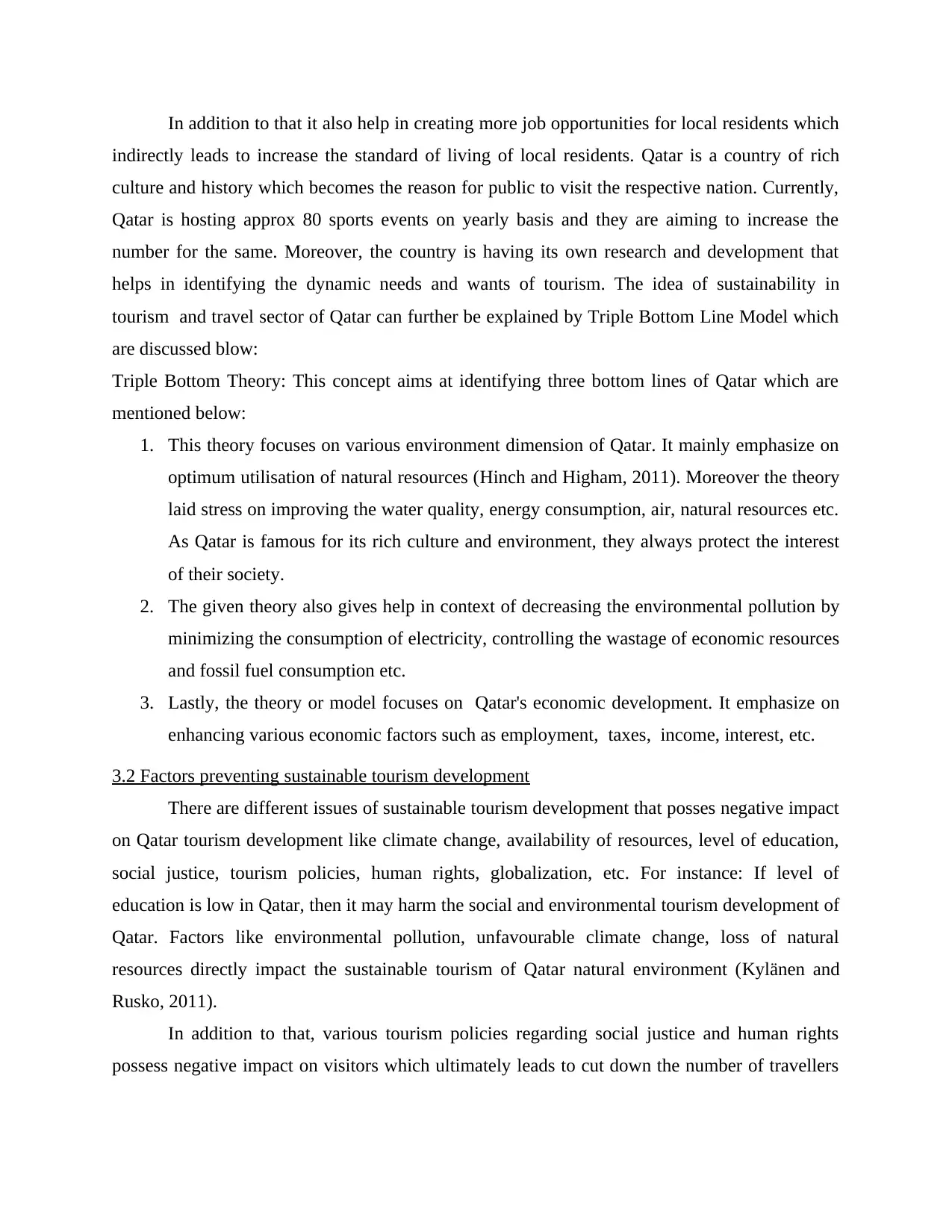
In addition to that it also help in creating more job opportunities for local residents which
indirectly leads to increase the standard of living of local residents. Qatar is a country of rich
culture and history which becomes the reason for public to visit the respective nation. Currently,
Qatar is hosting approx 80 sports events on yearly basis and they are aiming to increase the
number for the same. Moreover, the country is having its own research and development that
helps in identifying the dynamic needs and wants of tourism. The idea of sustainability in
tourism and travel sector of Qatar can further be explained by Triple Bottom Line Model which
are discussed blow:
Triple Bottom Theory: This concept aims at identifying three bottom lines of Qatar which are
mentioned below:
1. This theory focuses on various environment dimension of Qatar. It mainly emphasize on
optimum utilisation of natural resources (Hinch and Higham, 2011). Moreover the theory
laid stress on improving the water quality, energy consumption, air, natural resources etc.
As Qatar is famous for its rich culture and environment, they always protect the interest
of their society.
2. The given theory also gives help in context of decreasing the environmental pollution by
minimizing the consumption of electricity, controlling the wastage of economic resources
and fossil fuel consumption etc.
3. Lastly, the theory or model focuses on Qatar's economic development. It emphasize on
enhancing various economic factors such as employment, taxes, income, interest, etc.
3.2 Factors preventing sustainable tourism development
There are different issues of sustainable tourism development that posses negative impact
on Qatar tourism development like climate change, availability of resources, level of education,
social justice, tourism policies, human rights, globalization, etc. For instance: If level of
education is low in Qatar, then it may harm the social and environmental tourism development of
Qatar. Factors like environmental pollution, unfavourable climate change, loss of natural
resources directly impact the sustainable tourism of Qatar natural environment (Kylänen and
Rusko, 2011).
In addition to that, various tourism policies regarding social justice and human rights
possess negative impact on visitors which ultimately leads to cut down the number of travellers
indirectly leads to increase the standard of living of local residents. Qatar is a country of rich
culture and history which becomes the reason for public to visit the respective nation. Currently,
Qatar is hosting approx 80 sports events on yearly basis and they are aiming to increase the
number for the same. Moreover, the country is having its own research and development that
helps in identifying the dynamic needs and wants of tourism. The idea of sustainability in
tourism and travel sector of Qatar can further be explained by Triple Bottom Line Model which
are discussed blow:
Triple Bottom Theory: This concept aims at identifying three bottom lines of Qatar which are
mentioned below:
1. This theory focuses on various environment dimension of Qatar. It mainly emphasize on
optimum utilisation of natural resources (Hinch and Higham, 2011). Moreover the theory
laid stress on improving the water quality, energy consumption, air, natural resources etc.
As Qatar is famous for its rich culture and environment, they always protect the interest
of their society.
2. The given theory also gives help in context of decreasing the environmental pollution by
minimizing the consumption of electricity, controlling the wastage of economic resources
and fossil fuel consumption etc.
3. Lastly, the theory or model focuses on Qatar's economic development. It emphasize on
enhancing various economic factors such as employment, taxes, income, interest, etc.
3.2 Factors preventing sustainable tourism development
There are different issues of sustainable tourism development that posses negative impact
on Qatar tourism development like climate change, availability of resources, level of education,
social justice, tourism policies, human rights, globalization, etc. For instance: If level of
education is low in Qatar, then it may harm the social and environmental tourism development of
Qatar. Factors like environmental pollution, unfavourable climate change, loss of natural
resources directly impact the sustainable tourism of Qatar natural environment (Kylänen and
Rusko, 2011).
In addition to that, various tourism policies regarding social justice and human rights
possess negative impact on visitors which ultimately leads to cut down the number of travellers
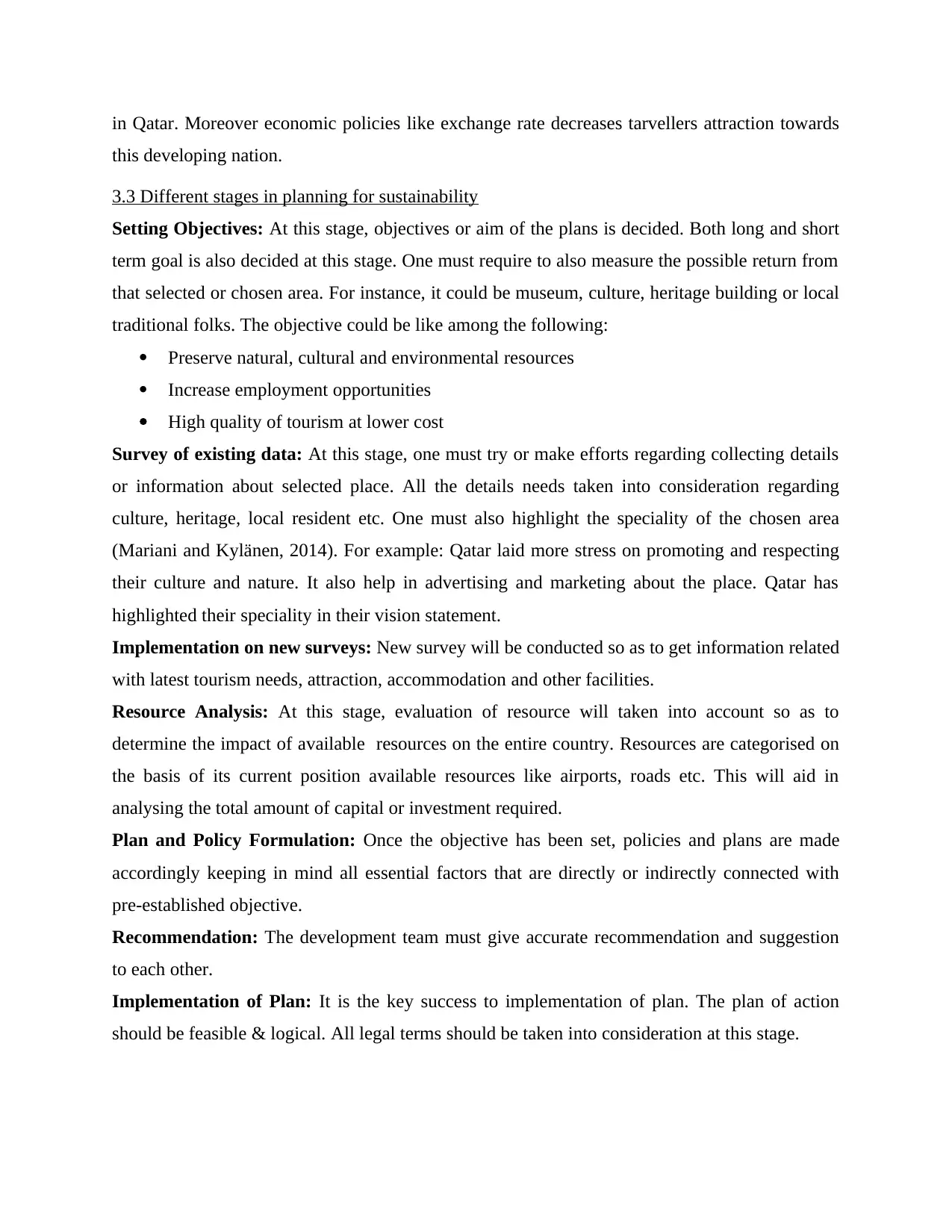
in Qatar. Moreover economic policies like exchange rate decreases tarvellers attraction towards
this developing nation.
3.3 Different stages in planning for sustainability
Setting Objectives: At this stage, objectives or aim of the plans is decided. Both long and short
term goal is also decided at this stage. One must require to also measure the possible return from
that selected or chosen area. For instance, it could be museum, culture, heritage building or local
traditional folks. The objective could be like among the following:
Preserve natural, cultural and environmental resources
Increase employment opportunities
High quality of tourism at lower cost
Survey of existing data: At this stage, one must try or make efforts regarding collecting details
or information about selected place. All the details needs taken into consideration regarding
culture, heritage, local resident etc. One must also highlight the speciality of the chosen area
(Mariani and Kylänen, 2014). For example: Qatar laid more stress on promoting and respecting
their culture and nature. It also help in advertising and marketing about the place. Qatar has
highlighted their speciality in their vision statement.
Implementation on new surveys: New survey will be conducted so as to get information related
with latest tourism needs, attraction, accommodation and other facilities.
Resource Analysis: At this stage, evaluation of resource will taken into account so as to
determine the impact of available resources on the entire country. Resources are categorised on
the basis of its current position available resources like airports, roads etc. This will aid in
analysing the total amount of capital or investment required.
Plan and Policy Formulation: Once the objective has been set, policies and plans are made
accordingly keeping in mind all essential factors that are directly or indirectly connected with
pre-established objective.
Recommendation: The development team must give accurate recommendation and suggestion
to each other.
Implementation of Plan: It is the key success to implementation of plan. The plan of action
should be feasible & logical. All legal terms should be taken into consideration at this stage.
this developing nation.
3.3 Different stages in planning for sustainability
Setting Objectives: At this stage, objectives or aim of the plans is decided. Both long and short
term goal is also decided at this stage. One must require to also measure the possible return from
that selected or chosen area. For instance, it could be museum, culture, heritage building or local
traditional folks. The objective could be like among the following:
Preserve natural, cultural and environmental resources
Increase employment opportunities
High quality of tourism at lower cost
Survey of existing data: At this stage, one must try or make efforts regarding collecting details
or information about selected place. All the details needs taken into consideration regarding
culture, heritage, local resident etc. One must also highlight the speciality of the chosen area
(Mariani and Kylänen, 2014). For example: Qatar laid more stress on promoting and respecting
their culture and nature. It also help in advertising and marketing about the place. Qatar has
highlighted their speciality in their vision statement.
Implementation on new surveys: New survey will be conducted so as to get information related
with latest tourism needs, attraction, accommodation and other facilities.
Resource Analysis: At this stage, evaluation of resource will taken into account so as to
determine the impact of available resources on the entire country. Resources are categorised on
the basis of its current position available resources like airports, roads etc. This will aid in
analysing the total amount of capital or investment required.
Plan and Policy Formulation: Once the objective has been set, policies and plans are made
accordingly keeping in mind all essential factors that are directly or indirectly connected with
pre-established objective.
Recommendation: The development team must give accurate recommendation and suggestion
to each other.
Implementation of Plan: It is the key success to implementation of plan. The plan of action
should be feasible & logical. All legal terms should be taken into consideration at this stage.
⊘ This is a preview!⊘
Do you want full access?
Subscribe today to unlock all pages.

Trusted by 1+ million students worldwide
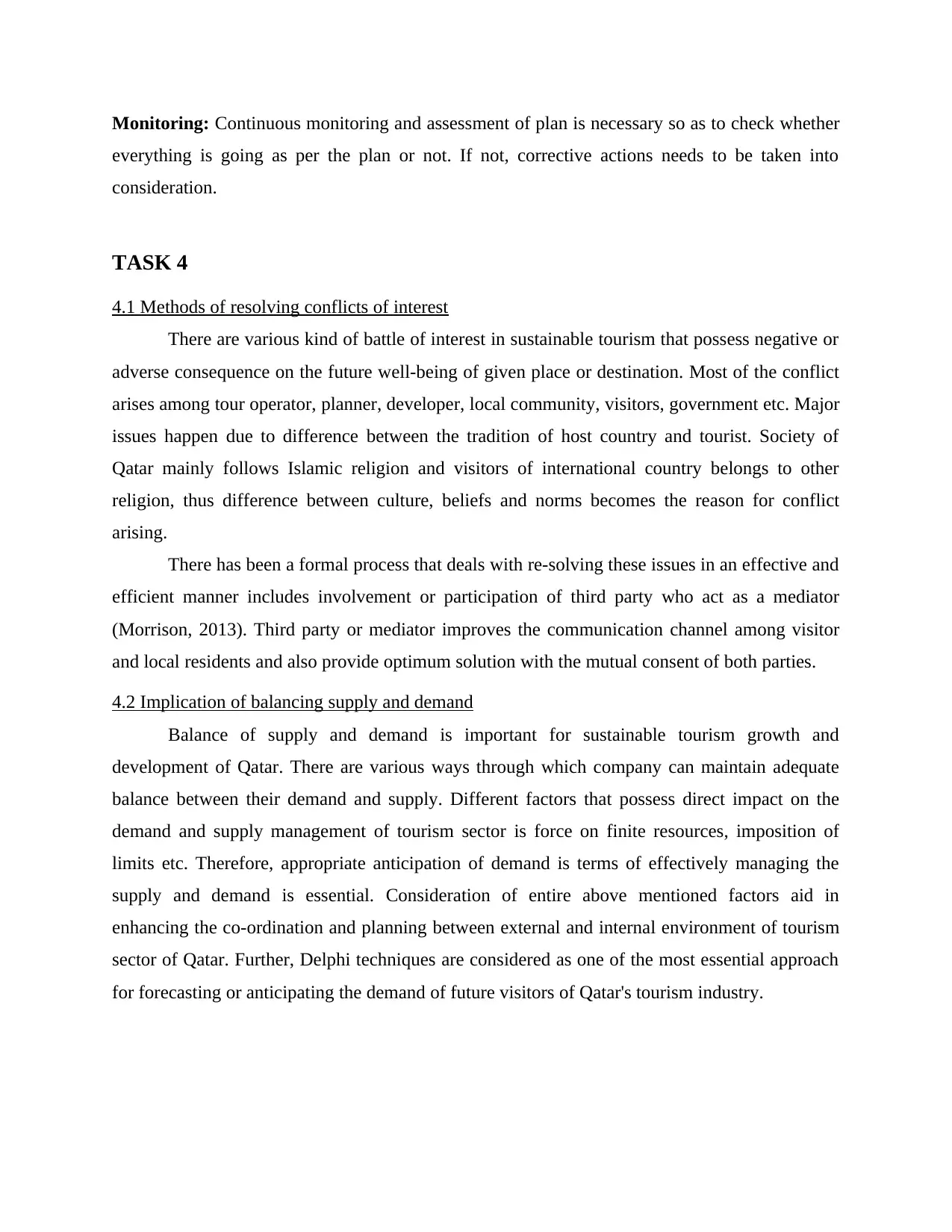
Monitoring: Continuous monitoring and assessment of plan is necessary so as to check whether
everything is going as per the plan or not. If not, corrective actions needs to be taken into
consideration.
TASK 4
4.1 Methods of resolving conflicts of interest
There are various kind of battle of interest in sustainable tourism that possess negative or
adverse consequence on the future well-being of given place or destination. Most of the conflict
arises among tour operator, planner, developer, local community, visitors, government etc. Major
issues happen due to difference between the tradition of host country and tourist. Society of
Qatar mainly follows Islamic religion and visitors of international country belongs to other
religion, thus difference between culture, beliefs and norms becomes the reason for conflict
arising.
There has been a formal process that deals with re-solving these issues in an effective and
efficient manner includes involvement or participation of third party who act as a mediator
(Morrison, 2013). Third party or mediator improves the communication channel among visitor
and local residents and also provide optimum solution with the mutual consent of both parties.
4.2 Implication of balancing supply and demand
Balance of supply and demand is important for sustainable tourism growth and
development of Qatar. There are various ways through which company can maintain adequate
balance between their demand and supply. Different factors that possess direct impact on the
demand and supply management of tourism sector is force on finite resources, imposition of
limits etc. Therefore, appropriate anticipation of demand is terms of effectively managing the
supply and demand is essential. Consideration of entire above mentioned factors aid in
enhancing the co-ordination and planning between external and internal environment of tourism
sector of Qatar. Further, Delphi techniques are considered as one of the most essential approach
for forecasting or anticipating the demand of future visitors of Qatar's tourism industry.
everything is going as per the plan or not. If not, corrective actions needs to be taken into
consideration.
TASK 4
4.1 Methods of resolving conflicts of interest
There are various kind of battle of interest in sustainable tourism that possess negative or
adverse consequence on the future well-being of given place or destination. Most of the conflict
arises among tour operator, planner, developer, local community, visitors, government etc. Major
issues happen due to difference between the tradition of host country and tourist. Society of
Qatar mainly follows Islamic religion and visitors of international country belongs to other
religion, thus difference between culture, beliefs and norms becomes the reason for conflict
arising.
There has been a formal process that deals with re-solving these issues in an effective and
efficient manner includes involvement or participation of third party who act as a mediator
(Morrison, 2013). Third party or mediator improves the communication channel among visitor
and local residents and also provide optimum solution with the mutual consent of both parties.
4.2 Implication of balancing supply and demand
Balance of supply and demand is important for sustainable tourism growth and
development of Qatar. There are various ways through which company can maintain adequate
balance between their demand and supply. Different factors that possess direct impact on the
demand and supply management of tourism sector is force on finite resources, imposition of
limits etc. Therefore, appropriate anticipation of demand is terms of effectively managing the
supply and demand is essential. Consideration of entire above mentioned factors aid in
enhancing the co-ordination and planning between external and internal environment of tourism
sector of Qatar. Further, Delphi techniques are considered as one of the most essential approach
for forecasting or anticipating the demand of future visitors of Qatar's tourism industry.
Paraphrase This Document
Need a fresh take? Get an instant paraphrase of this document with our AI Paraphraser
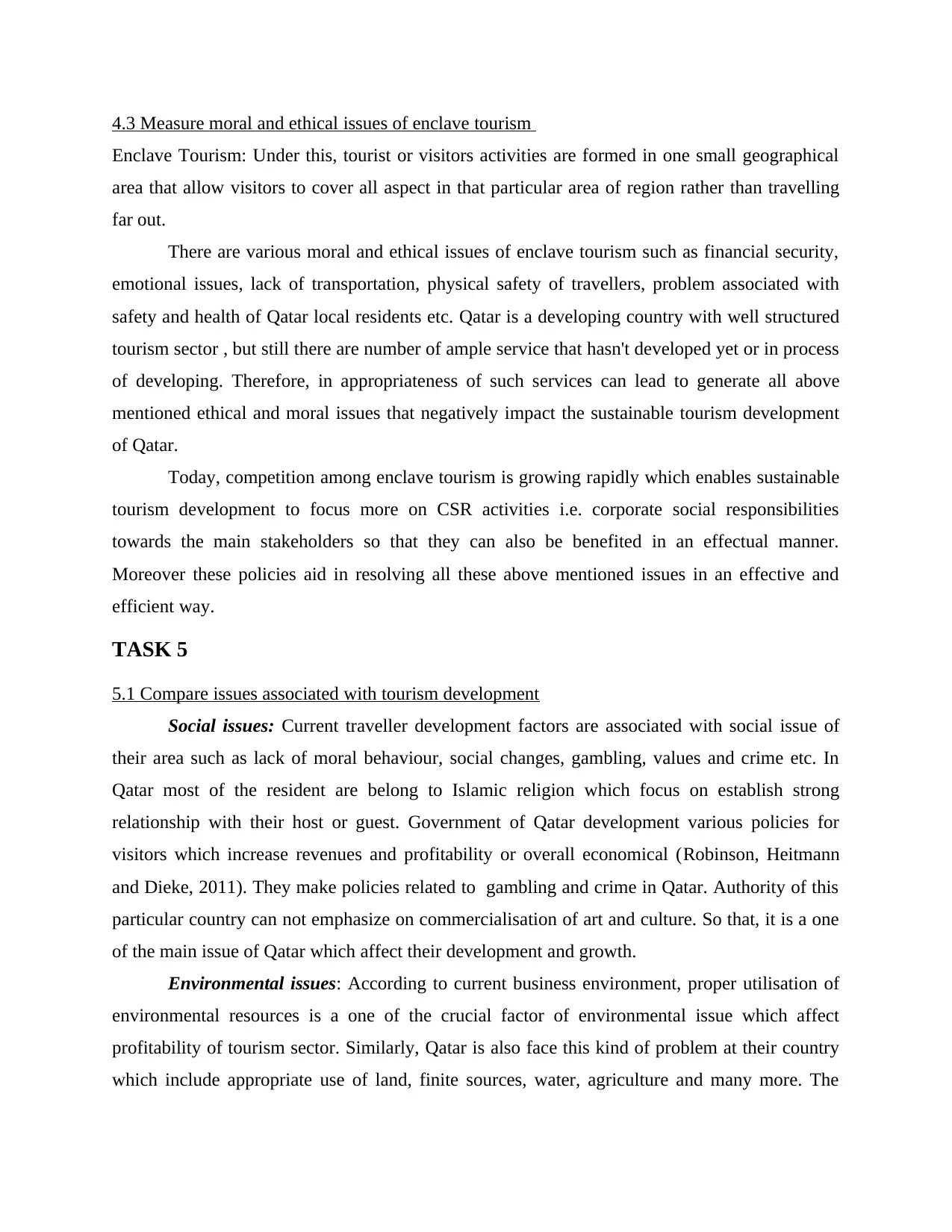
4.3 Measure moral and ethical issues of enclave tourism
Enclave Tourism: Under this, tourist or visitors activities are formed in one small geographical
area that allow visitors to cover all aspect in that particular area of region rather than travelling
far out.
There are various moral and ethical issues of enclave tourism such as financial security,
emotional issues, lack of transportation, physical safety of travellers, problem associated with
safety and health of Qatar local residents etc. Qatar is a developing country with well structured
tourism sector , but still there are number of ample service that hasn't developed yet or in process
of developing. Therefore, in appropriateness of such services can lead to generate all above
mentioned ethical and moral issues that negatively impact the sustainable tourism development
of Qatar.
Today, competition among enclave tourism is growing rapidly which enables sustainable
tourism development to focus more on CSR activities i.e. corporate social responsibilities
towards the main stakeholders so that they can also be benefited in an effectual manner.
Moreover these policies aid in resolving all these above mentioned issues in an effective and
efficient way.
TASK 5
5.1 Compare issues associated with tourism development
Social issues: Current traveller development factors are associated with social issue of
their area such as lack of moral behaviour, social changes, gambling, values and crime etc. In
Qatar most of the resident are belong to Islamic religion which focus on establish strong
relationship with their host or guest. Government of Qatar development various policies for
visitors which increase revenues and profitability or overall economical (Robinson, Heitmann
and Dieke, 2011). They make policies related to gambling and crime in Qatar. Authority of this
particular country can not emphasize on commercialisation of art and culture. So that, it is a one
of the main issue of Qatar which affect their development and growth.
Environmental issues: According to current business environment, proper utilisation of
environmental resources is a one of the crucial factor of environmental issue which affect
profitability of tourism sector. Similarly, Qatar is also face this kind of problem at their country
which include appropriate use of land, finite sources, water, agriculture and many more. The
Enclave Tourism: Under this, tourist or visitors activities are formed in one small geographical
area that allow visitors to cover all aspect in that particular area of region rather than travelling
far out.
There are various moral and ethical issues of enclave tourism such as financial security,
emotional issues, lack of transportation, physical safety of travellers, problem associated with
safety and health of Qatar local residents etc. Qatar is a developing country with well structured
tourism sector , but still there are number of ample service that hasn't developed yet or in process
of developing. Therefore, in appropriateness of such services can lead to generate all above
mentioned ethical and moral issues that negatively impact the sustainable tourism development
of Qatar.
Today, competition among enclave tourism is growing rapidly which enables sustainable
tourism development to focus more on CSR activities i.e. corporate social responsibilities
towards the main stakeholders so that they can also be benefited in an effectual manner.
Moreover these policies aid in resolving all these above mentioned issues in an effective and
efficient way.
TASK 5
5.1 Compare issues associated with tourism development
Social issues: Current traveller development factors are associated with social issue of
their area such as lack of moral behaviour, social changes, gambling, values and crime etc. In
Qatar most of the resident are belong to Islamic religion which focus on establish strong
relationship with their host or guest. Government of Qatar development various policies for
visitors which increase revenues and profitability or overall economical (Robinson, Heitmann
and Dieke, 2011). They make policies related to gambling and crime in Qatar. Authority of this
particular country can not emphasize on commercialisation of art and culture. So that, it is a one
of the main issue of Qatar which affect their development and growth.
Environmental issues: According to current business environment, proper utilisation of
environmental resources is a one of the crucial factor of environmental issue which affect
profitability of tourism sector. Similarly, Qatar is also face this kind of problem at their country
which include appropriate use of land, finite sources, water, agriculture and many more. The
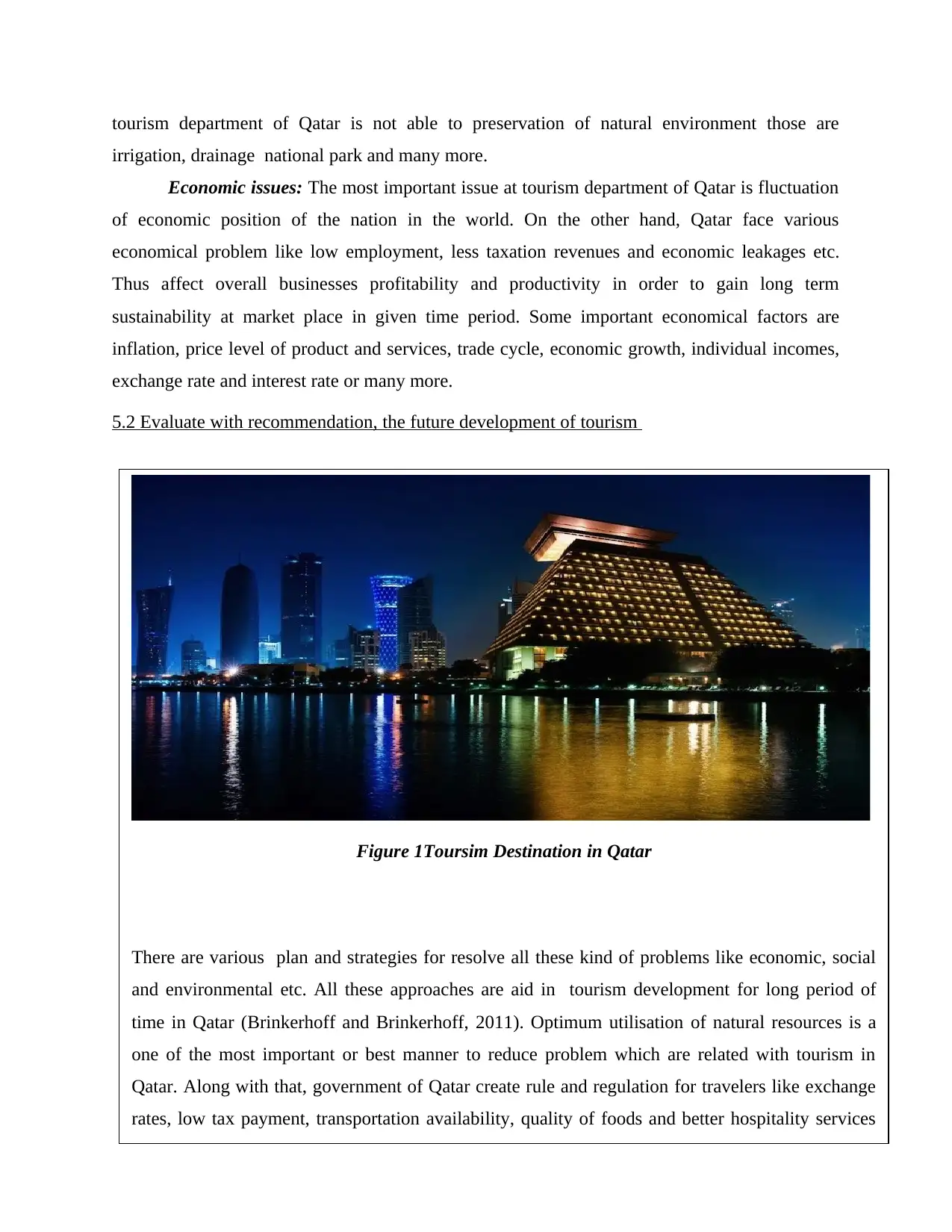
tourism department of Qatar is not able to preservation of natural environment those are
irrigation, drainage national park and many more.
Economic issues: The most important issue at tourism department of Qatar is fluctuation
of economic position of the nation in the world. On the other hand, Qatar face various
economical problem like low employment, less taxation revenues and economic leakages etc.
Thus affect overall businesses profitability and productivity in order to gain long term
sustainability at market place in given time period. Some important economical factors are
inflation, price level of product and services, trade cycle, economic growth, individual incomes,
exchange rate and interest rate or many more.
5.2 Evaluate with recommendation, the future development of tourism
Figure 1Toursim Destination in Qatar
There are various plan and strategies for resolve all these kind of problems like economic, social
and environmental etc. All these approaches are aid in tourism development for long period of
time in Qatar (Brinkerhoff and Brinkerhoff, 2011). Optimum utilisation of natural resources is a
one of the most important or best manner to reduce problem which are related with tourism in
Qatar. Along with that, government of Qatar create rule and regulation for travelers like exchange
rates, low tax payment, transportation availability, quality of foods and better hospitality services
etc. It is also resolve economical as well as political issues. Involvement of shareholders in firm
irrigation, drainage national park and many more.
Economic issues: The most important issue at tourism department of Qatar is fluctuation
of economic position of the nation in the world. On the other hand, Qatar face various
economical problem like low employment, less taxation revenues and economic leakages etc.
Thus affect overall businesses profitability and productivity in order to gain long term
sustainability at market place in given time period. Some important economical factors are
inflation, price level of product and services, trade cycle, economic growth, individual incomes,
exchange rate and interest rate or many more.
5.2 Evaluate with recommendation, the future development of tourism
Figure 1Toursim Destination in Qatar
There are various plan and strategies for resolve all these kind of problems like economic, social
and environmental etc. All these approaches are aid in tourism development for long period of
time in Qatar (Brinkerhoff and Brinkerhoff, 2011). Optimum utilisation of natural resources is a
one of the most important or best manner to reduce problem which are related with tourism in
Qatar. Along with that, government of Qatar create rule and regulation for travelers like exchange
rates, low tax payment, transportation availability, quality of foods and better hospitality services
etc. It is also resolve economical as well as political issues. Involvement of shareholders in firm
⊘ This is a preview!⊘
Do you want full access?
Subscribe today to unlock all pages.

Trusted by 1+ million students worldwide
1 out of 14
Related Documents
Your All-in-One AI-Powered Toolkit for Academic Success.
+13062052269
info@desklib.com
Available 24*7 on WhatsApp / Email
![[object Object]](/_next/static/media/star-bottom.7253800d.svg)
Unlock your academic potential
Copyright © 2020–2025 A2Z Services. All Rights Reserved. Developed and managed by ZUCOL.




